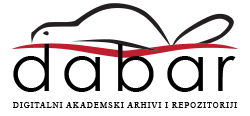Title Glikozilacija imunoglobulina kod djece s atopijom Title (english) Immunoglobulin glycosylation in atopic children Author Marija Pezer Mentor Mirjana Turkalj (mentor)Mentor Gordan Lauc (sumentor)Committee member Mladen Merćep (član povjerenstva)Committee member Drago Batinić (član povjerenstva)Committee member Vlatka Zoldoš (član povjerenstva)Granter University of Zagreb Defense date and country 2013, Croatia Scientific / art field, NATURAL SCIENCES Universal decimal classificationUDC ) 577 - Biochemistry. Molecular biology. Biophysics Abstract Imunoglobulin G (IgG) smatra se jednim od modulatora imunog odgovora u atopijskim bolestima, najčešće putem interakcija s Fcγ receptorima (FcγR) na površini imunoloških efektorskih stanica, a naročito inhibitornog receptora FcγRIIB. Diferencijalna N-glikozilacija Fc regija IgG utječe na afinitet IgG za FcγR, te stoga možda predstavlja jedan od mehanizama regulacije imunog odgovora u atopijskim bolestima. Ukupni N-glikom plazme (engl. total plasma N-glycome, TPNG) i N-glikom IgG djece po sastavu i dobnoj dinamici razlikuju se od onog u odraslih, što zahtijeva odvojene analize N-glikoma ove dvije populacije. Kako bi se utvrdilo postoji li povezanost između specifičnog N-glikoprofila IgG i atopijskih bolesti u pedijatrijskoj populaciji, ova studija ispitala je TPNG i N-glikoprofil IgG u djece koja pate od atopijskih bolesti i zdrave djece. Prikupljena je periferna krv 61 pedijatrijskog pacijenta i 74 zdrave djece oba spola starosti od 5 do 18 godina. Plazma je odvojena centrifugiranjem, te IgG izoliran afinitetnom kromatografijom pomoću proteina G. TPNG je ispitan tekućinskom kromatografijom visoke učinkovitosti s hidrofilnim interakcijama, a N-glikom IgG tekućinskom kromatografijom ultravisoke učinkovitosti s hidrofilnim interakcijama. N-glikozilacijski profil IgG kod djece s atopijom pokazao se specifičnim za ovaj protein, te različitim od onog kod zdrave djece. Udio većine jednostavnih, manjih, nesijaliniziranih struktura u ukupnim N-glikanima IgG manji je, a udio većih, većinom sijaliniziranih složenih struktura uglavnom veći kod djece s atopijom. Udio sijaliniziranih (naročito disijaliniziranih), digalaktoziliranih i sržno fukoziliranih (većinom bez presijecajućeg GlcNAc) struktura veći je, dok je udio agalaktoziliranih struktura i udio struktura s presijecajućim GlcNAc manji nego kod zdrave djece, što je u načelu suprotno od glikoprofila IgG i drugih proteina koji uobičajeno karakteriziraju upalna stanja. Analiza N-glikozilacije IgG ima zbog toga potencijal da se razvije u predispozicijski, dijagnostički i/ili prognostički marker za atopijske bolesti kod djece, te pruža temelj za istraživanje ovog područja s ciljem razvoja novih vrsta bioloških terapeutika za liječenje atopijskih bolesti.
Abstract (english) Immunoglobulin G (IgG) is considered one of modulators of immune response in atopic diseases, most often through interactions with Fcγ receptors (FcγR) on the surface of immune effector cells, and especially with the inhibitory receptor FcγRIIB. Differential N-glycosylation of IgG Fc regions affects the IgG affinity for FcγR, and thus maybe represents one of regulatory mechanisms of immune response in atopic diseases. Children's total plasma N-glycome (TPNG) and IgG N-glycome differ in composition and age dynamics from those found in adults, requiring independent N-glycome analyses of the two populations. To verify the existence of an association between a specific IgG N-glycoprofile and atopic diseases in pediatric population, this study examined TPNG and IgG N-glycoprofile in atopic vs. healthy children. Peripheral blood was collected from 61 patients and 74 healthy controls of both sexes aged 5-18 years. Plasma was separated by centrifugation and IgG isolated by affinity chromatography using protein G. TPNG was examined by hydrophilic interaction high performance liquid chromatography, and IgG N-glycome by hydrophilic interaction ultra performance liquid chromatography. A protein specific IgG N-glycosylation profile different from the one in healthy children was found. The content of majority of simple, smaller, asialylated structures in total IgG N-glycome was smaller and the content of greater, mainly sialylated complex structures was mostly greater in children with atopy. The content of sialylated (especially disialylated), digalactosilated and core fucosylated (mostly without GlcNAc) structures was greater, while the content of agalactosylated and the content of structures with bisecting GlcNAc was smaller in comparison with healthy children, displaying a glycoprofile in principle opposite from the one usually observed in IgG and other proteins in inflammatory conditions. The analysis of IgG N-glycoslyation thus has the potential to be developed into a predisposition, diagnostic and/or prognostic biomarker for atopic diseases in children, and provides a ground for further research in the area, aiming at the development of novel class of biological therapeutics for the treatment of atopic diseases.
Keywords
alergija
atopija
imunoglobulin G
glikozilacija
N-glikom
pedijatrijska populacija
Keywords (english)
allergy
atopy
immunoglobulin G
glycosylation
N-glycome
pediatric population
Language croatian URN:NBN urn:nbn:hr:217:170166 Study programme Title: Biology Type of resource Text File origin Born digital Access conditions Closed access Terms of use Repository Repository of the Faculty of Science Created on 2017-05-24 09:03:09

